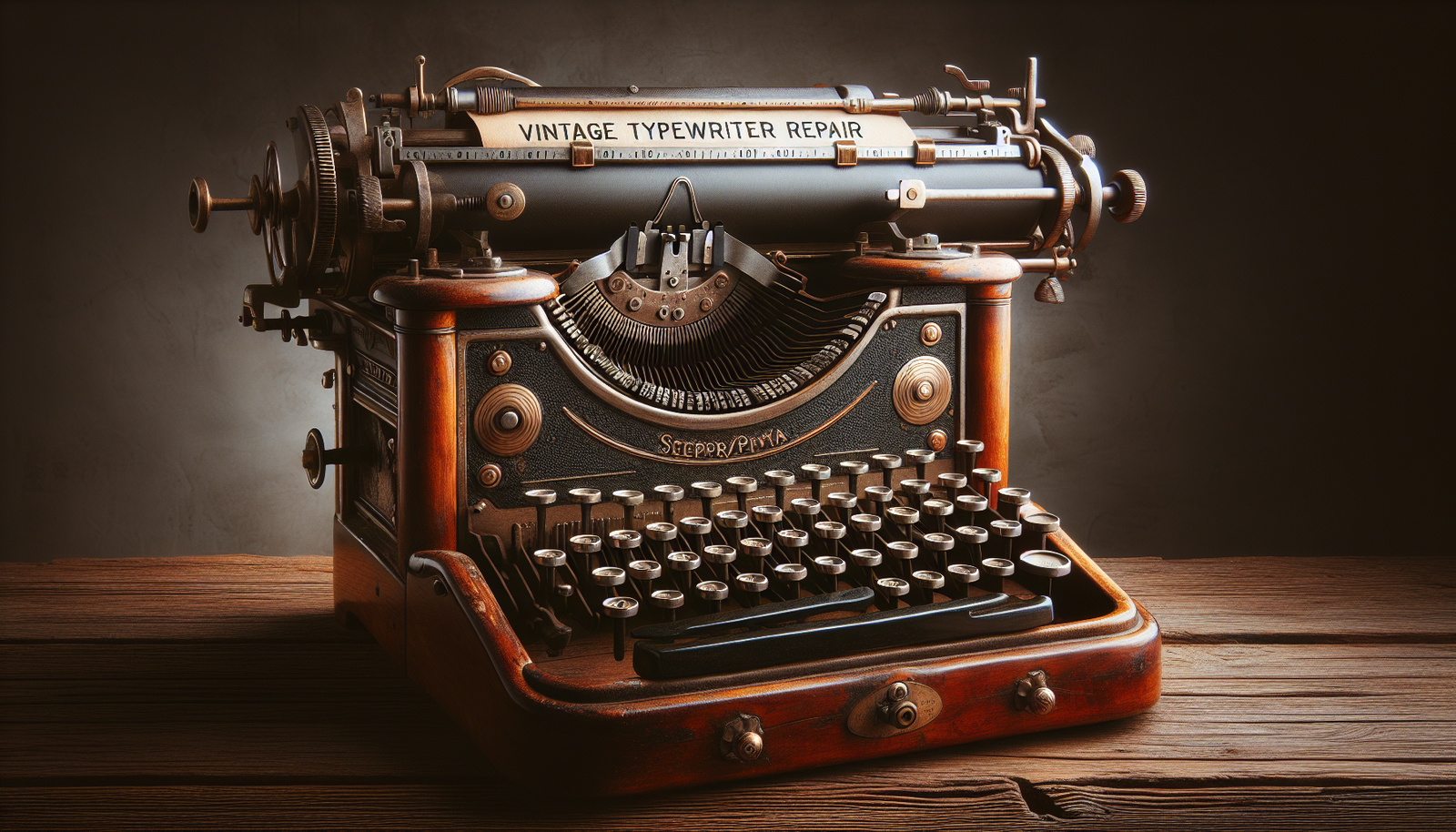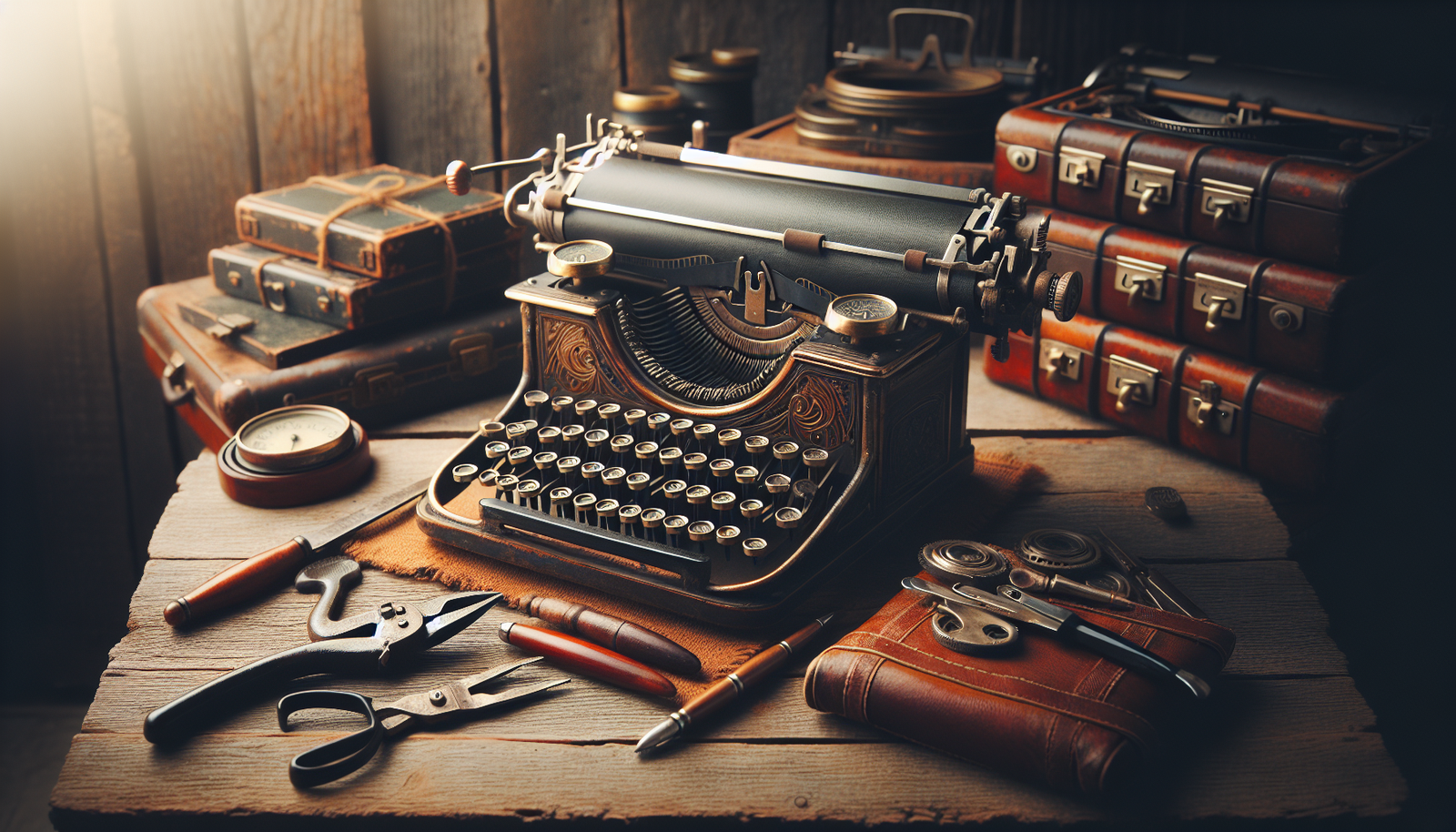Vintage Typewriter Repair
Imagine finding an old vintage typewriter tucked away in your attic or stumbled upon in a thrift store. The sight of this classic and elegant machine transports you back to a bygone era, when the clack of keys and the ding of the carriage return were the soundtrack of writers and journalists. But alas, you notice that the once pristine typewriter is in desperate need of repair. Don’t fret, for there are experts out there who specialize in vintage typewriter repair. These skilled artisans have the knowledge and expertise to revive these iconic pieces of history, ensuring that they can once again bring the magic of the written word to life. So, whether you have a sentimental attachment to a family heirloom or simply appreciate the beauty of a vintage typewriter, turn to the experts who can bring these marvelous machines back to their former glory.
Introduction to Vintage Typewriters
vintage typewriters hold a special place in our hearts. The nostalgia and charm they bring can transport us back to a simpler time when technology was a bit more tactile. Whether you’re a collector or just an enthusiast, it’s important to understand the history and evolution of these machines. From their invention in the 19th century to the various types available, vintage typewriters have a fascinating story to tell. In this article, we’ll explore the world of vintage typewriters, common issues that may arise, the tools required for repairs, and various techniques to keep these timeless machines in perfect working condition.
Common Issues with Vintage Typewriters
While vintage typewriters are built to last, they can encounter a few issues over time. Sticky keys and a stuck carriage are often one of the most common problems typewriter owners face. Uneven and inconsistent typing may also plague these machines. Additionally, missing or broken parts, deteriorated rubber and platen, ink and ribbon problems, and overall dust and dirt buildup are issues that vintage typewriter owners may encounter. Frozen or rusty components can also hinder the functionality of these classic typewriters. But fear not! In the following sections, we’ll discuss how to address each of these issues and restore your vintage typewriter to its former glory.

Tools Required for Vintage Typewriter Repair
Before diving into the repair process, it’s essential to have the right tools at your disposal. Some basic tools that every typewriter owner must have include screwdrivers, tweezers, a brush, microfiber cloths, and rubber rejuvenator. These tools will help you perform routine maintenance tasks and address minor issues. However, for more advanced repairs, specialized tools such as a plunger-aligner, needle-nose pliers, and a typewriter key puller may be necessary. It’s important to invest in these tools to ensure that you have everything you need to keep your vintage typewriter in top shape. Additionally, don’t forget to prioritize safety precautions by wearing protective gear such as gloves and goggles when working on your typewriter.
Cleaning and Maintenance
Regular cleaning and maintenance are vital for the longevity of your vintage typewriter. Dust and debris can accumulate in the inner mechanisms, causing keys to stick and affecting overall performance. Start by removing any dust and debris using a soft brush or compressed air. For deeper cleaning, you can use solvents and lubricants specifically designed for typewriters. These cleaning agents will help remove grime and prevent corrosion. Don’t forget to maintain proper lubrication by applying oil to key parts to ensure smooth operation. Lastly, taking preventive measures such as storing your typewriter in a dry and clean environment will help prevent corrosion and rust.

Replacing Typewriter Ribbons
One of the most crucial components of a vintage typewriter is the ribbon. Over time, the ink in the ribbon will dry up, resulting in faded or incomplete typing. The good news is that replacing typewriter ribbons is relatively easy and can greatly improve the quality of your typing. Start by understanding the type of ribbon your typewriter requires, as there are various options available. Identify the correct ribbon by measuring its width and determining the spool style. Once you have the replacement ribbon, follow a step-by-step guide to remove the old ribbon and install the new one. Additionally, adjusting the ribbon tension is essential for optimal performance.
Repairing Stuck Keys
Stuck keys can be a frustrating issue for typewriter owners. When a key refuses to move or gets stuck halfway, it can interrupt your typing flow. The first step in addressing this issue is to diagnose the cause. It could be due to dirt or debris obstructing the key mechanism, a lack of lubrication, or even a broken spring. Start by cleaning the stuck keys using a soft brush and lubricating them with typewriter oil. If the issue persists, the spring may need to be repaired or replaced. Properly aligning the key levers can also help resolve stuck key problems and ensure smooth, uninterrupted typing.
Fixing Alignment and Spacing Issues
If you notice misaligned characters or spacing issues in your typing, it’s time to delve into the alignment and spacing adjustments of your vintage typewriter. Start by identifying which characters are misaligned and make adjustments to the margin and tab settings accordingly. Resetting line and character spacing can also help improve the overall appearance of your typed text. Additionally, calibrating the carriage to ensure it moves smoothly across the page is crucial. By addressing these alignment and spacing issues, you can ensure that your vintage typewriter produces neat, professional-looking documents.
Solving Paper Feeding Problems
Paper feeding issues can be a significant hurdle when using a vintage typewriter. Problems such as jams, misfeeds, or uneven paper movement can disrupt your typing experience. To solve these problems, start by identifying the specific issues with the paper feed mechanism. Cleaning the paper feed components and applying lubricant can help address minor issues. Adjusting the paper guides and feed rollers can also improve the paper’s alignment and movement. In severe cases, worn paper feed components may need to be replaced to ensure smooth paper feeding. By addressing paper feeding problems, you’ll be able to enjoy a hassle-free typing experience.
Repairing Broken or Damaged Parts
Over time, some parts of your vintage typewriter may break or become damaged. It’s essential to address these issues promptly to prevent further damage and ensure uninterrupted use. If your typewriter is missing or has broken parts, consider consulting a professional typewriter repair service. They will be able to source the necessary replacement parts and return your typewriter to perfect working condition. However, if you have the technical skills and confidence, you can attempt to repair or replace broken or damaged parts yourself. Online resources and typewriter communities can provide guidance and support in this matter.
Restoring the Aesthetics of a Vintage Typewriter
Vintage typewriters are not only cherished for their functionality but also for their aesthetic appeal. If your typewriter’s appearance has deteriorated over time or you simply want to give it a facelift, restoring its aesthetics is a rewarding project. Start by cleaning the exterior using mild soap and water, being careful not to damage any labels or decals. Depending on the material of your typewriter, you may need to use specialized cleaning agents. If the paint is chipped or faded, consider repainting it using high-quality enamel paint. Restoration of the platen and rubber parts can also enhance the typewriter’s aesthetics. With a bit of time and effort, you can revitalize your vintage typewriter and enjoy its beauty for years to come.
Where to Find Vintage Typewriter Repair Services
While some typewriter repairs can be done at home, there may be instances where professional assistance is required. If you’re not confident in your repair skills or if your typewriter requires specialized repairs, it’s best to seek the help of a vintage typewriter repair service. Local typewriter repair shops are a great place to start, as they often have experienced technicians who specialize in vintage typewriter repairs. Online vintage typewriter repair services also offer convenience, allowing you to ship your typewriter to a qualified technician who can handle the necessary repairs. When choosing a repair service, consider their expertise, reputation, and customer reviews to ensure you’re entrusting your typewriter to reliable hands. Additionally, DIY resources and online communities can provide valuable guidance and support for those who prefer to tackle typewriter repairs themselves.
Vintage typewriters have a timeless appeal, and keeping them in excellent condition is essential for their functionality and aesthetic value. By understanding common issues, acquiring the necessary tools, and following the appropriate repair techniques, you can ensure that your vintage typewriter continues to serve you faithfully. So, if you find yourself in possession of a vintage typewriter, don’t let any issues deter you. Embrace the charm, take care of your machine, and enjoy the satisfying experience of typing on a piece of history.




